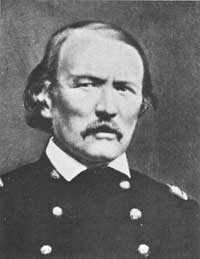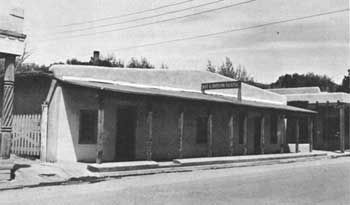





Survey of Historic Sites and Buildings
 |
CARSON ("KIT") HOUSE New Mexico |
 |
| ||
Between 1843 and 1868 this was the home of Christopher ("Kit") Carson, probably the most renowned of all the mountain men—a legend in his own lifetime. Fur trapper, trader, and guide, he was a dominant figure in the fur trade, but he also served as an Indian agent and won distinction in the Indian wars.
A native of Kentucky who spent most of his youth in Missouri, Carson (1809-68) in 1826 emigrated west over the Santa Fe Trail. In the late 1820's he entered the fur trade at Taos, rendezvous and winter headquarters for many independent trappers. They operated over a large arc of territory extending from the headwaters of the Rio Grande and Arkansas River across the deserts to the San Juan, Gila, Salt, and Colorado Rivers. Reopening the old Spanish trails to California, they were among the first Americans to make a lodgment there. About 1836 Carson married, in Indian fashion, an Arapaho girl, who died bearing him a daughter.
 |
| Col. Christopher "Kit" Carson, ex-mountain man, led New Mexico Volunteers in highly successful campaigns against the Indians of the Southwest. (Denver Public Library, Western Collection) |
The fur trade began to decline in the mid-1830's, and many trappers and traders retired in Taos. Carson, returning from duty as guide for Fremont's first expedition (1842), moved there. In 1843 he remarried. His bride was Maria Josefa Jaramillo daughter of a prominent and wealthy local family and sister of the wife of Charles Bent. The same year, Carson purchased what came to be known as the Kit Carson House, which had been built in 1825.
For the next 25 years Carson resided in the home only intermittently, but apparently six of the seven children he and Maria had were born there. His diverse activities kept him away for long stretches of time. He was a guide for Fremont's second expedition (1843-44). Going to California in 1845 with the third, between then and early 1849 he took an active part in the U.S. conquest of California. He then returned to Taos.
In 1851 Carson began managing a ranch on Rayado Creek east of the Sangre de Cristo Mountains, where his family joined him. The longest continuous period he lived in the Taos house was from early 1854 until 1861, during which time he was Indian agent, mainly for two bands of Utes. For several months in 1854, until another building was available, he used the house as agency headquarters.
At the outbreak of the Civil War, in 1861, Carson resigned as Indian agent and entered a new phase of his multifaceted career. Aiding in organizing the 1st New Mexico Volunteer Infantry, he was commissioned as lieutenant colonel in July and only 2 months later as colonel. For his gallantry in the Battle of Valverde, N. Mex., against a Confederate force from Texas, and for other distinguished service in New Mexico, he won a brevet of brigadier general in January 1866. Under the direction of Gen. James H. Carleton, commander of the Department of New Mexico, Carson conducted highly successful campaigns against the Mescalero Apaches (1862-63); the Navajos (1863-64); and the Kiowas and Comanches (1864-65), in which he fought his last engagement, the Battle of Adobe Walls, Tex.
 |
| "Kit" Carson House. (Kit Carson Memorial Foundation, Inc.) |
In the summer of 1866 Carson assumed command of Fort Garland, Colo., taking his family with him, but he had to resign in November 1867 because of ill health. The next spring he again relocated his family, from Taos to Boggsville, Colo. But he died at nearby Fort Lyon (No. 2) in May, shortly after the birth of their seventh child took his wife's life. They were buried there, but the bodies were later moved to Taos.
The Kit Carson Memorial Foundation, Inc., administers the house on behalf of Bent Masonic Lodge #42, the owner and restorer. Four rooms of the U-shaped residence are original and three of them—the parlor, kitchen, and bedroom—are authentically refurnished in a combination of Spanish Colonial and Territorial styles. The fourth original room features displays associated with Carson's life. The remaining rooms serve as exhibit rooms and offices. The well-preserved exterior features a patio and typical Spanish mud oven. Carson and his wife are buried in Kit Carson Memorial State Park, at the end of Dragoon Lane, elsewhere in town.
NHL Designation: 05/23/63
 |
 |
http://www.cr.nps.gov/history/online_books/soldier-brave/siteb19.htm
Last Updated: 19-Aug-2005